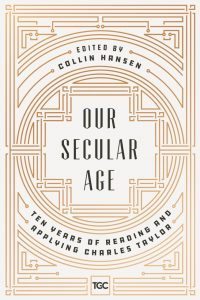Religious freedom is reshaping the world. But while precious, it has come with a high cost.
Historically, all our forms of social order—political, economic, familial, ecclesial, and social—assumed that society would share a religion, or at least a metaphysic and worldview. So they have all been undermined by the pluralism that religious freedom permits. And we have not yet figured out how to build new forms of social order that will be stable and just without enforcing orthodoxy.
Without a common god, we lack a common good. That is the first challenge. It is hard to find shared moral ground on which to build a way of living in peace with each other. This is why worldliness and strife are increasing in our communities.
But there is a second and deeper challenge. Religious freedom brings with it a different way of experiencing religion itself. It destabilizes all religious positions—not just fidelity to this or that religion but even belief and unbelief simply as such. It is harder now to be a really committed Christian, or even a really committed theist; it is also, in a different way, harder to be a really committed atheist. Our chaotic cultural environment undermines the sources of moral character and intellectual confidence. The only thing that has become easier (at least in the short term) is therapeutic deism and being “spiritual but not religious”—passively surrendering to each spiritual mood as it happens along.
The challenge of advanced modernity is not simply that Christians stand here and atheists stand there, and we lack common ground. It has also gotten much harder for anyone to stand on any ground.
The challenge of advanced modernity is not simply that Christians stand here and atheists stand there, and we lack common ground. It has also gotten much harder for anyone to stand on any ground.
As our religious, political, economic, and social crises increase, more people realize that confronting this challenge is not optional for either the church or the nations. The church’s crisis of discipleship (we have millions of Christians whose daily lives look the same as everyone else’s) and the crisis of public virtue and solidarity in our nations (public communities that are materialistic, polarized, and degenerating) have a common root. Growing strong in the faith and living in peace with our neighbors both require us to invent new ways of living for the new world religious freedom has created.
To effectively evangelize, disciple, and do justice and mercy, we must embrace anew the modern commitment to religious freedom. But we must embrace it as our early modern ancestors did—as an uncompleted project, aimed at discovering solutions to an unsolved problem. It is hard to admit ignorance. But if we admit that the project of religious freedom is incomplete and the problem unsolved, we can overcome the paralysis that otherwise threatens to overwhelm the church.
History Has Produced a New Religious Consciousness
Most American evangelicals frame the problem something like this: The church is basically the same as it ever was (it follows the same gospel, after all), but the world has suddenly and inexplicably gone mad. The fallen world was always dysfunctional, but it used to be dysfunctional in relatively routine and predictable ways. Now it is totally haywire. Fortunately, we have social scientists and philosophers and other professional smart people to tell us why the world went crazy and hand us a well-developed set of solutions we can implement.
Here is a better frame: Christianity in the advanced modern world faces enormous new challenges, and also enormous new opportunities, because religious freedom is transforming every kind of social structure. Religious freedom and modern ways of viewing the world are deeply interdependent, and have destabilized not only the social order but even religion itself. They have produced a new kind of religious consciousness. Religion is now something different, for believers and unbelievers alike. We do not yet understand our new situation well enough to know how to cope with these changes—individually, or as a church, or as nations. The only viable option is to trust God through the infallible Bible and the supernatural transformation of the Holy Spirit to lead us, like Abram, out into the wilderness.
Religion is now something different, for believers and unbelievers alike.
We are sojourning to a new land. Where we are going is known to God, but not yet to us—not even to the social scientists and philosophers and professional smart people.
Evangelicals cheer when you say we must trust God through the infallible Bible and the supernatural transformation of the Holy Spirit. But they march with torches and pitchforks if you dare to talk about historical changes having brought about a new kind of religious consciousness.
The evangelical movement as we know it was formed in a reaction against “modernist” theologies that overemphasized Keeping Up with History at the expense of fidelity to eternal truth, so evangelicals have long been suspicious of historical consciousness.
I am heartened, however, by increasing signs that we are discovering the importance of history. Among evangelical leaders, 50 years’ worth of complex scholarly discussion of modernity and religion is at last beginning to get a serious hearing. “Unknown unknowns” are becoming “known unknowns.” Charles Taylor’s A Secular Age has been an important source for that conversation, as have Lesslie Newbigin’s works, Dallas Willard’s The Divine Conspiracy, James Davison Hunter’s To Change the World, Peter Berger’s The Many Altars of Modernity, and others. It’s even becoming possible to hope that someday soon we will start taking the Niebuhr brothers seriously again.
Immanent Frame Reshapes Our Universe
Central to Taylor’s book is the concept of the immanent frame—a certain way of looking at the world of daily experience. It interprets all phenomena we encounter in the world other than the activity of human minds as explainable by mechanistic natural causes. The exclusion of the human mind from the domain of natural causes (which is accepted by all but a few hardcore materialists) is important. The immanent frame presents us with a fully explainable natural world, but also with a sense of ourselves as existing separate from that world and also from the supernatural world. Our consciousness becomes what Taylor calls a “buffered self ” rather than a “porous self.”
The immanent frame can be held in a way that is “open” to the supernatural (i.e., we see supernatural causes at work in our world, working behind and through natural causes). Or it can be “closed” (i.e., we hold that natural causes are the only forces at work in the natural world). The existence of the immanent frame makes secularism possible as a stable and publicly legitimized way of life, but it does not compel secularism.
Before modernity, seeing the world through the immanent frame was so implausible that it was for practical purposes impossible to live with that mindset. All public and social institutions were built on the assumption that the world of daily experience is suffused with many kinds of supernatural operations—working not behind and through natural causes but independently, excluding natural explanations.
Today, everyone—the Christian, the Muslim, the Hindu, the atheist and the wishy-washy Spiritual But Not Religionist alike—sees the world through the immanent frame. People have many different ways of understanding the thinking, feeling, and willing of the human mind, ranging from the image of God to Darwinian algorithms to the divine spark of Brahmin metaphysics. But everyone agrees about why water flows downhill and electrical current follows the path of least resistance and water boils at 212 degrees Fahrenheit. They do this because Isaac Newton commands them to.
The immanent frame empowers us for all the blessings of modernity, and inflicts all its woes on us as well. It is indispensable to modern science and rapid technological progress. It also provides a common social world that facilitates peace among peoples of different nations and religions, and the harmony that makes economic prosperity possible. It also drains the ordinary world of its deepest moral and spiritual significance, consigning not only atheists but also Christians and everyone else to struggle to find real meaning and purpose in their everyday lives. Worldliness becomes easier, feeding both cynicism and fanaticism.
‘Reform’ and Religious Freedom Create and Sustain the Immanent Frame
Why did it take so long for the immanent frame to emerge, and why did every civilization on earth resist it for so long? Secularists tell a “subtraction story,” in which the irrationality of religious belief and the cynical use of religion for social control were all that ever stood in the way of the immanent frame. Then along came the Reason Fairy to sprinkle Enlightenment Dust on our heads; religion was subtracted from the picture, and the immanent frame naturally emerged. Taylor debunks this story at some length.
Instead, he blames the spirit of Reform. The capitalized “Reform” is distinct from “reform.” The former seeks comprehensive innovation and improvement across the whole canvas of human experience and social organization, while the latter seeks marginal improvements and treats the basic structure of human institutions as natural and permanent.
To sum up Taylor’s complex argument briefly: In primitive religions around the world, our drives for immoral forms of violence and sexuality were accepted and normalized. Religious rituals provided a socially legitimate outlet to contain them. These religions were interdependent with the porous self; there was not much boundary between the mind, the body, the natural world, and the supernatural. To see the world as something to be manipulated and controlled by us (i.e., the immanent frame) requires a buffered self that conceives of “the world” and “us” as radically separate things. This was simply not how the ancient mind understood itself. As mature religions emerged worldwide in what is known as the “Axial age” in the first millennium B.C., religious rituals that incorporated our lust for vengeance and obscenity were condemned. People now aspired to levels of self-discipline, compassion, and dignity that would eliminate immoral violence and sex rather than ritualize them. This produced a new mindset—a new way of understanding both ourselves and our world—that ultimately became the spirit of Reform. And as we sought more and more control over our world in order to Reform it, the immanent frame emerged, along with the buffered self: minds that experience the world as something radically separate from themselves.
There is much to commend this account. However, with Berger, I would emphasize the special role of religious freedom in producing the immanent frame in its fully developed form. For one thing, this account is enormously helpful in explaining why the immanent frame emerged with such enormous force in Europe, at the specific time it did, and spread elsewhere from there (through both colonization and persuasion) rather than developing indigenously in every part of the world. Taylor himself emphasizes—and is careful to clearly condemn—the role of the Reformation as the supreme exemplar of the spirit of Reform.
It is true, as Taylor relates, that the spirit of Reform helped produce the religious division of Europe in the Reformation. People like Luther and Calvin and the Radical Reformers were prepared to overthrow even the greatest and most important social structures, if it was the right thing to do. They did not take the empire and the papacy to be natural, permanent features of human life.
However, it is also true that once the religious division of the Reformation proved intractable, the spirit of Reform turned right around and produced an unexpected remedy: religious freedom. It was Christ’s cause of justice and mercy— the spirit of Reform—that demanded we learn to live in peace with one another. At first we made civil peace among Christians, then with those of all faiths, and finally with those of no faith. Eventually, a whole new kind of social order had to be invented to accommodate this demand for living in peace together; we are still in the process of inventing it.
This stage was essential to the final development of the immanent frame, and remains essential today to its continuing social dominance. We cannot live in peace with one another if our mental universes are totally different. Religious freedom therefore created a drive to find a shared way of speaking and acting together in public spaces with those of other beliefs.
We cannot live in peace with one another if our mental universes are totally different. Religious freedom therefore created a drive to find a shared way of speaking and acting together in public spaces with those of other beliefs.
To borrow an example from Berger, the Christian pilot and the atheist co-pilot need a shared discourse (i.e., a common mode of communication) if they’re going to fly the plane through a storm together. The pilot believes that the storm might be turned aside through prayer. He may pray silently, but he can’t bring prayer into the shared discourse with his co-pilot. They need an immanent frame; they can’t fly the plane without it.
Once the presence of religious plurality becomes normalized, the immanent frame must be normalized with it. At that point, even if the pilot and co-pilot are both Christians, it will not feel normal or natural for them to pray together in the flight deck.
 Editors’ note: This is an excerpt from Greg Forster’s chapter in Our Secular Age: Ten Years of Reading and Applying Charles Taylor, now available at Amazon (Kindle | Paperback) and WTS Books. Other excerpts:
Editors’ note: This is an excerpt from Greg Forster’s chapter in Our Secular Age: Ten Years of Reading and Applying Charles Taylor, now available at Amazon (Kindle | Paperback) and WTS Books. Other excerpts:
- The Cross-Pressured Life of Kanye West (Mike Cosper)
- Discipleship is Not Consumer-Friendly (Brett McCracken)
- The Disruptive Witness of Art (Alan Noble)
- The Healing Power of Bodily Presence (Robert Cutillo)
- Hope in Our Secular Age (Collin Hansen)
- Lose Yourself in a ‘Find Yourself’ World (Jen Pollock Michel)
- Ministering to Millennials in a Secular Age (Derek Rishmawy)
- How to Preach to a Secular Age (John Starke)
Is there enough evidence for us to believe the Gospels?
 In an age of faith deconstruction and skepticism about the Bible’s authority, it’s common to hear claims that the Gospels are unreliable propaganda. And if the Gospels are shown to be historically unreliable, the whole foundation of Christianity begins to crumble.
In an age of faith deconstruction and skepticism about the Bible’s authority, it’s common to hear claims that the Gospels are unreliable propaganda. And if the Gospels are shown to be historically unreliable, the whole foundation of Christianity begins to crumble.


































